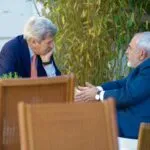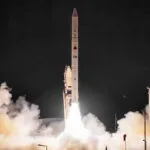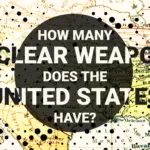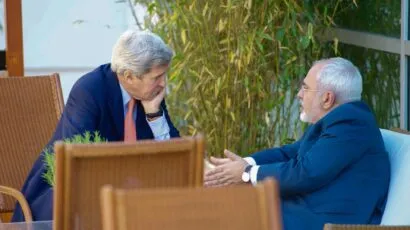Duke’s Peter Feaver on the president and US nuclear command and control
By John Mecklin | November 30, 2017
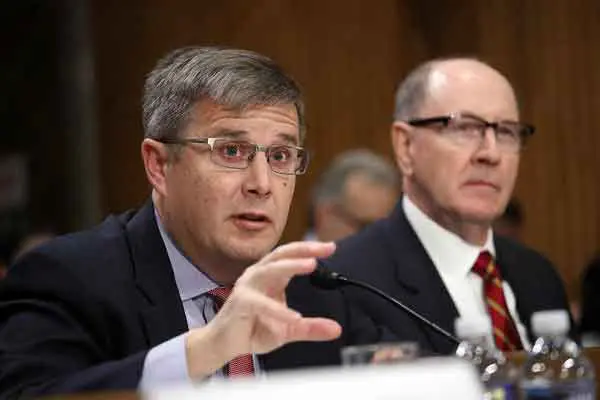
Peter Feaver is a political science and public policy professor at Duke University who has served on the National Security Council for two presidents and is an expert in the sub-field often known as civil-military or political-military affairs. From mid-2005 to mid-2007, he was special advisor for strategic planning and institutional reform on the National Security Council staff in the George W. Bush White House. In 1993–94, he was director for defense policy and arms control on the National Security Council in the Bill Clinton administration.
His combination of experience in and scholarship on civilian control of nuclear weapons made him a featured witness at a recent US Senate Foreign Relations Committee hearing on the president’s significant authority to order the use of nuclear weapons. In the wake of that hearing—born of bipartisan concerns about President Trump’s volatile response to foreign policy problems, especially during the continuing face-off with North Korea—I spoke in some depth with Feaver about how the US nuclear command-and-control system might be made safer, regardless of who is president.
JOHN MECKLIN: I was hoping you could talk to me a little bit about what might a command-and-control system for US nuclear enterprise look like that would involve more than one person, just a president, giving the order? Is there one that would pass constitutional muster?
PETER FEAVER: Well, such a system has to pass both constitutional muster and, also, the national security desiderata, right—[meaning a system] that doesn’t undermine deterrence and does not create failure modes that would [make] the cure worse than the disease. The history of nuclear command and control is the history of discovering that certain measures were taken, and then we learned that there were second- and third-order effects that were not intended and required a shift back. It’s an incremental, almost trial-and-error kind of approach. Now, obviously, we can’t tolerate an error that produces a nuclear explosion, so there’s a cautionary bias built into the system. I’m not saying that they try reckless things, but they have tried things, done things that then they think better of, and they change them. I’m quite prepared to believe that there are ways of reforming our current system that would be worth doing and would pass constitutional muster, but I’m wary of imposing that from the outside with a simple legislative fix.
MECKLIN: Can you give an example of one of these attempted reforms that was then later thought better of? Or are they all classified?
FEAVER: Well, there was an effort to improve the responsiveness of the force in the ’50s, so that our airplanes could not be caught in a sneak attack. In response, they put aircraft on quick action alert—on the tarmac, gassed, fueled, and ready to go, with nuclear ordnance hanging under their wing. This was an understandable response to the, then, Soviet air threat. We didn’t have intercontinental-range bombers, so we were bombing from bases within range of the Soviet Union, which were in Europe, for the most part. But that put them in range of Soviet systems as well, so… the Soviets could catch us, [and] destroy the planes and the ordnance on the ground before they could even take off. So the response was quick action alert. Then that raised questions about nuclear sharing arrangements, because some of these were not US planes, US pilots—these were allied pilots. That raised questions. That took the nuclear sharing further than Congress was comfortable with. Because, remember, Congress had mandates that the US had to maintain custody of the weapons, except when it came time to actually use them. Then they would be transferred [to allied forces].
They were saying, “Now wait a second, we’ve gone too far here. We’ve got allied pilots with a nuclear capability on their wing, under their wing, gassed and ready to go. What if they started the war in some precipitous way?” So that led to the impetus to build these coded locks into the system, so that you could then scramble the airplanes, thus keep them alive, but send the coded message that would unlock the weapon later. So that was a step-one fix to solve one problem. Then they needed to do something to step two to fix the problem created by step one.
A reform that [might be useful] would maybe set in motion a presidential order to launch, but then delay the actual launch by a certain period of time, because in that scenario you would not be trying to use them before you lose them. We have survivable response systems, submarines especially, that are very survivable. So a president could give the order, but then not have the order carried out immediately. There could be some delay in the carrying out of the order, and especially if that was a policy set in place by the president, that would easily pass constitutional muster. But then you’d want to think through, carefully, what are the downsides of that system, and does that introduce other kinds of problems?
One reason not to have a legislative fix, but just a policy change within the executive branch, is you can change that policy more quickly… and more confidentially, without explaining to the whole world what was the unintended vulnerability that you had introduced. You could do it just within the executive branch. I think there are changes like that, probably quite a few, that would be worth considering.
MECKLIN: It seems to me that whatever solution to this perceived problem of just one person controlling the nuclear launch decision might be, the president, or the White House, will have to agree to it. Do you agree with that?
FEAVER: I think that trying to impose something from Congress over the objections of the executive branch in this area is unlikely to work, because, first of all, that raises the commander-in-chief considerations in the Constitution. In an area that was more easily within congressional authority, the [War Powers] Act has not functioned the way the legislators intended. Every president has refused to acknowledge that it is a binding constraint on him, and the courts have not backed it up.
I don’t think that you could impose over a determinedly hostile executive branch a legislative fix that actually would work. But [Congress] could cooperate with the executive branch on legislative fixes, and better yet, it could, through oversight and review, make recommendations that the executive branch would adopt on its own, recognizing that they’re worth doing.
MECKLIN: I know you’ve had a couple of stints on the National Security Council. Did you ever get any sense that a president would willingly somehow cede some of that authority, even within the executive branch? Make it a two-key decision or a three-key decision. Did you ever get any sense that was possible in any of the presidents you’ve known?
FEAVER: Not in a formal sense. But I never got the sense that the presidents I worked for—whether it was Clinton or Bush 43, or any of the other presidents that I studied in writing about this—I never got the sense that they were reckless about their nuclear use authority to the point that someone had to constrain them. There was concern, particularly in the early days, civilian concern about the risk acceptance of the military. One of the reasons to put the decision power in the president’s hands, and not in the military’s hands, was as a check on a military that might make a decision different from what the civilian wanted in the case.
The concern was always ensuring the president had a say in this. And the concerns that you’ve heard, at least from the Democratic side of the Senate Foreign Relations Committee, was the opposite, really. They were concerned that the President had the authority and [it] wasn’t shared across his more junior subordinates. But when you press them on what they’re concerned about, at least some of the concerns, I think, appear to be based on a misreading of how the system works. You hear this often. You hear people saying the president can fire off a nuke as easy as it is to fire off a tweet. That’s simply not true. If that’s your concern, that the president can fire off a tweet, so how can we stop a nuke—that concern, I think, is already addressed by the command-and-control system. It is much harder to fire off a nuke than it is for the president to fire off a tweet. It involves the cooperation of more people.
There are some experts who understand how the system actually works who nevertheless say we also need more constraints on the president. They are making more sophisticated arguments that are worth considering. But the more simplistic argument that the president can use nuclear weapons like he can use his Twitter account—I think that’s a fear that is grossly overstated.
MECKLIN: What would happen if a president ordered Stratcom to use nuclear weapons in sort of a preventative, or a first-use case? Can you lay out why it is that you say it’s not as easy as firing off a tweet in that case?
FEAVER: The system is primed to respond very quickly in the demanding scenario where the United States is experiencing an attack; it’s under attack, and the military has detected this and alerted the president, and is telling the president, “You only have a short period of time, tens of minutes, less than half an hour, to make a decision.” It could be even more demanding than that, depending how long it took the military to verify that this threat of an attack was real, and not a mistake, and not an error in the intelligence-collection system. So the president has very limited time to make a decision, he alone makes the decision under that extremely demanding scenario, and the system practices to be able to carry out the response even under extremely demanding time constraints. The purpose of that is pretty clear: You make sure the adversary knows that even if it launches a, quote, “from the blue” attack, it will not be able to decapitate and neutralize the US nuclear arsenal. Their understanding that they can’t do that strengthens deterrence. In that scenario, it moves quickly and goes from presidential decision to action pretty quickly.
That’s not the scenario that is motivating people to worry about the president today. When the senators, the Democratic senators, were critiquing Trump, they were talking about the president himself being hot-headed and creating a crisis where there was none, and then being able to launch nuclear weapons in a hurry, because he has this capability during an actual launch-under-attack scenario. There was this belief that since the system was primed to respond under an emergency, it will respond that way during the normal course of events. That’s not a realistic picture of how civil-military relations works in the US. The military does subordinate itself to civilian authority, and does, at the end of the day, salute the president. But [military officials] also raise questions for the president, when asked to do things that they find deeply troubling, or worse. Being ordered to launch a nuclear war, unprovoked, would fall under that category. They’d raise questions. They’d ask, “Why is this legal?” They would have to get a ruling that this is legal.
Remember they won’t feel the time pressure, because the US is not under attack. There’s time to consult the lawyers. There’s probably time for this to leak, and show up on TV, or show up in the newspaper, and, thus, raise questions from Congress. That’s not a hypothetical. Look at controversial things that this and previous presidents have tried to do. They tended to leak, and they tended to raise concerns that then got fully addressed. Now, if the president is absolutely determined, he might be able to prevail, as did President Bush in the decision to invade Iraq. But along the way, the Bush administration persuaded quite a lot of people to support that decision, including the bipartisan majority in Congress, to support that decision. So I think something like a nuclear use would be even more consequential, and would require an even bigger lift.
MECKLIN: In terms of exploring some of the nuclear command-and-control reforms that you mentioned may be possible with Congress and the executive branch cooperating, do you see, in the current circumstance, any way in which this White House would cooperate with Congress in such a matter? I’m just having a hard time, in this day and age, wrapping my mind around: The Congress will make some recommendations, and the White House will look at them and get with Congress and implement some kind of reform within the executive branch based on recommendations from Congress—but without legislation. I just have a difficult time envisioning that. Do you think it’s possible nowadays? Maybe in the past it was.
FEAVER: Well, I understand your skepticism. It does feel like Washington, DC’s political process is broken, to a certain extent. They are finding it very hard to do much simpler things than this, much less consequential things than this. So your skepticism is understandable.
I think it’s also the case that it’s possible to convince the executive branch that you can reassure the American public that you are wielding this power responsibly. And you can do that in a way that would also bolster deterrence for adversaries by making it clear that the president is not able to fire off nukes the way he fires off tweets. That would go some distance to reassuring the public.
Some of the reforms that you can imagine—like the waiting on the execution of the launch order, or creating a policy where other cabinet members validate that the order is legal, complies with US treaty obligations, or something along those lines—[might work if they were] not imposed by Congress, but were just a policy. This is similar to how the Obama administration laid out very, very strict guidelines for how they would fire off a drone, and they publicized them in a way so as to reassure the public on this. I think that you could make the case that the Trump administration would benefit from doing something similar [in the nuclear weapons realm], while also keeping enough strategic ambiguity about crisis situations so as to deny an adversary the thought that they could do a first strike.
That was long-winded way of saying I can see some political benefit, or at least strategic benefit, to the administration of reassuring the public on these matters. That would be worth doing.
MECKLIN: There were some parts of the testimony, or the discussion, in the Senate hearing that better missile defense might sort of create that cushion of time that would take some pressure off a president. I think I remember that was one of your contentions and I just wanted to hear you explain that, why you think that’s so.
FEAVER: I believe that President Trump, like the other presidents before him, would want advisors to weigh in before he made a nuclear decision. The only case in which he wouldn’t get that is if time and circumstances did not permit because the attack was so imminent, because [the adversary] had, through other means, decapitated or interrupted the communications nodes, or something else had gone wrong. If time allowed for it, and communications allowed for it, the president would want to talk to as many of his advisors as possible, his key advisors. I’m not saying that they would want to talk to Congress. They may or may not. I can imagine an executive branch wanting to make a decision without consulting with Congress, even though I can also imagine that the executive branch would be well advised to get congressional input.
What I’m quite confident [of] is that the president would want other people advising him on the nuclear use decision. The question then is: How do we make sure that he can have the time he needs to get that contemplation? You want to harden the communication system, so it doesn’t have failures at the crucial moments. And you would like to give the president the option of not responding while the missiles are in the air. His range of choice would be maximized if he knew that the ballistic missile defense was likely to shoot down the missiles, and if it, in fact, did shoot down the missiles, so he was responding not to a devastating attack on the United States, but responding to an attack that had been thwarted. Under those conditions, he’d have maximum time to consult with advisors, and so it wouldn’t fall just on a single person’s shoulders.
So that’s why I think ballistic missile defense could contribute to mitigating some of the concerns.
MECKLIN: Wouldn’t also just increasing the survivability of all the legs of the arsenal?
FEAVER: Yes. That’s why [former Defense] Secretary [William] Perry has said let’s increase the survivability of the land-based [intercontinental ballistic missile] leg by just getting rid of it. Then we don’t have to worry about it. Rely just on the much more survivable submarine force, augmented perhaps by bombers that could take off without actually striking. They could take off and then fly to a holding pattern or something and extend the decision time that way. So, yes, that would also do it, but particularly when you’re dealing with threats, a missile-based threat from North Korea—and/or say, from Iran, that’s the other small-state adversary—a robust missile defense would offer a lot of assurance that would give the president much more time.
MECKLIN: I told you I’d take up half an hour of your life, and it’s been 33 minutes now, so I’ve got just one more question, and I’ll let you go. In terms of the nuclear modernization program that the United States has embarked on, I guess the current cost estimate is something like $1.2 trillion over 30 years. And there are a lot of questions about whether the money is actually going to be there, given all the things that are needed in other parts of the military and the rest of the government. In terms of what we’ve been talking about, are there specific things in the nuclear modernization program that you think are first on the priority list? Things that they need to make sure and do these?
FEAVER: What I would say first is that there needs to be a fresh look at nuclear command and control, with an opening to modernizing the system in response to quite robust cyber threats and other kinds of problems that are much more severe today than they were during the Cold War. We ended up with the system we had because we were facing a particular type of enemy, the Soviet Union, that had tens of thousands of weapons that could fly in a very limited time frame—20 minutes is the worst for a depressed trajectory submarine launch [of a missile] off the coast. We had a system that was designed for that threat. The world has a very different but still menacing array of threats; we might want to optimize the command-and-control system for this new array of threats. I would want to do that first, and then I would say whatever came out of the Nuclear Posture Review is what I would I’d make priority number one for spending.
Together, we make the world safer.
The Bulletin elevates expert voices above the noise. But as an independent nonprofit organization, our operations depend on the support of readers like you. Help us continue to deliver quality journalism that holds leaders accountable. Your support of our work at any level is important. In return, we promise our coverage will be understandable, influential, vigilant, solution-oriented, and fair-minded. Together we can make a difference.
Topics: Analysis, Nuclear Weapons


